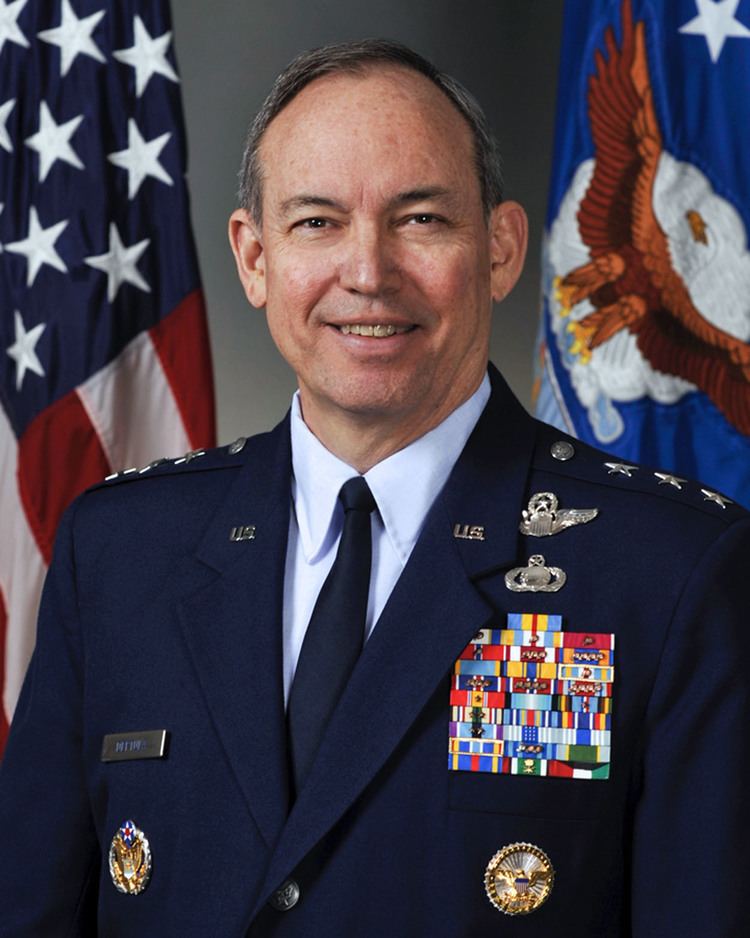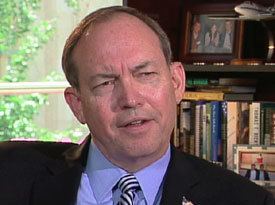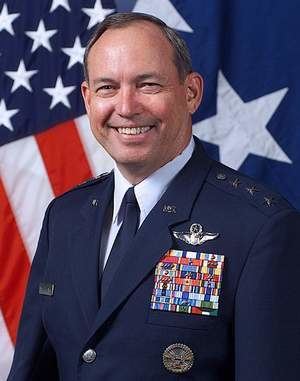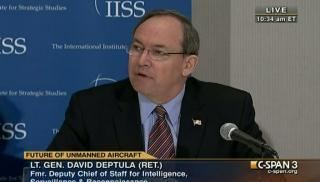Years of service 1976–2010 | Name David Deptula | |
 | ||
Commands held 33d Operations Group (F-15); C/JTF Commander, Operation Northern Watch; Combined Air Operations CenterOperation Enduring Freedom; Joint Force Air Component CommanderOperation Unified Assistance; Vice Commander Pacific Air Forces; JTF CommanderOperation Deep Freeze; Kenny Warfighting Headquarters (13th Air Force) Battles/wars Operation Unified Assistance Operation Iraqi Freedom Operation Enduring Freedom Operation Northern Watch Operation Desert StormOperation Desert Shield | ||
Cnbc closing bell lt gen david deptula usaf ret should the war in afghanistan be privatized
David A. Deptula is the Dean of the Mitchell Institute of Aerospace Power Studies. He transitioned from the U.S. Air Force in 2010 at the rank of Lieutenant General after more than 34 years of service. General Deptula was commissioned in 1974 as a distinguished graduate from The University of Virginia Air Force ROTC program, and remained to complete a master's degree in 1976. During his military career he took part in operations, planning, and joint warfighting at unit, major command, service headquarters and combatant command levels, and also served on two congressional commissions outlining America’s future defense posture. He was a principal author of the original Air Force White Paper "Global Reach—Global Power." In the early 1990s he was instrumental in the formation and development of the concept later known as "effects-based operations," having successfully applied it in building the attack plans for the Operation Desert Storm air campaign. He has been cited as having "... fostered the most significant change in the conduct of aerial warfare since Billy Mitchell...Deptula’s framework influenced the successful air campaigns in Operations Allied Force, Iraqi Freedom, and Enduring Freedom. Today, joint targeting cells and Air Force doctrine reflect Deptula's theory of airpower and the changing nature of warfare."
Contents
- Cnbc closing bell lt gen david deptula usaf ret should the war in afghanistan be privatized
- Mitchell Institutes Deptula on USAFs Next Generation ISR Dominance Flight Plan
- Leadership in Combat and Contingency Operations
- Intelligence Surveillance Reconnaissance and Drone Leadership
- Military Career Summary
- Post Military Career
- Publications
- Education
- Assignments
- Joint assignments
- Flight information
- References
Mitchell Institute's Deptula on USAF's Next-Generation ISR Dominance Flight Plan
Leadership in Combat and Contingency Operations

Deptula has significant experience in combat and leadership in several major joint contingency operations. He was the principal attack planner for the Desert Storm coalition air campaign in 1991. He has twice been a Combined/Joint Task Force Commander – in 1998/1999 for the Operation Northern Watch no-fly zone where he flew 82 combat missions as a general officer, and for Operation Deep Freeze in Antarctica. In 2001, he served as Director of the Combined Air Operations Center for Operation Enduring Freedom where he orchestrated air operations over Afghanistan in response to the terrorist attacks of 9/11/2001. In 2005, he was the Joint Force Air Component Commander (JFACC) for Operation Unified Assistance, the South Asia tsunami relief effort, and in 2006 he was the standing JFACC for Pacific Command. He has piloted more than 3,000 flying hours (400 in combat) to include multiple fighter aircraft command assignments in the F-15.
Intelligence, Surveillance, Reconnaissance, and Drone Leadership

Deptula was the first Deputy Chief of Staff for Intelligence, Surveillance and Reconnaissance at Air Force Headquarters, and was involved in shaping and managing military use of unmanned aerial vehicles. Responsible for policy formulation, planning, and leadership of AF ISR and remotely piloted aircraft (RPA)—also known as drones—he initiated and built the Air Force’s first ISR Strategy, established the Air Force ISR Agency, and constructed an Air Force ISR flight plan that established processes to optimize ISR decisions to resource that strategy. He published the first USAF RPA/drone flight plan that together with the ISR strategy formed an ISR enterprise intended to transition the military from an era of industrial age warfare to the information age.
Military Career Summary

Deptula began his USAF career as a pilot earning his wings in 1977. Upon graduation, he was assigned an F-15C air superiority fighter, and went on to serve in a number of fighter squadrons in a variety of roles to include duty as an F-15 aerial demonstration pilot. He attended the USAF Fighter Weapons School, and became a squadron, and then wing weapons officer. His first staff assignment was in USAF Legislative Liaison. The remainder of his career he spent alternating between operational assignments commanding fighter units and in joint operations, with staff assignments at Headquarters USAF, Major Air Force Commands, and with the Office of the Secretary of Defense. Notable assignments included: Policy and issues analyst, Secretary of the Air Force Policy Group; Principal offensive air campaign planner for Operation Desert Shield, and Director, Iraq Target Planning Group, Operation Desert Storm; Commander, Combined/Joint Task Force for Operation Northern Watch (ONW), U.S. European Command; Director, 2001 Air Force Quadrennial Defense Review (QDR); Director, Combined Air Operations Center (CAOC), Operation Enduring Freedom (OEF) 2001; Commander of the General George C. Kenney Warfighting Headquarters, and Vice Commander, Pacific Air Forces; Joint Force Air Component Commander (JFACC)—Operation Unified Assistance—the South Asia tsunami relief effort; and Deputy Chief of Staff (DCS) for Intelligence, Surveillance and Reconnaissance (ISR), Headquarters USAF. An editorial on the impact of his military career appeared in the Air Force Times on August 2, 2010.
Post-Military Career

Deptula’s post-military retirement life involves research, education, and advocacy on matters relating to national security. He has served as a senior scholar at the U.S. Air Force Academy Center for Character and Leadership Development; on the Defense Science Board task force on innovation for the future; participated in the crafting of "A New Defense Strategy for a New Era" as a member of the Peter G. Peterson Foundation Defense Advisory Committee; as a senior adviser to the Gemunder Center for Defense & Strategy; and as an adviser to the NATO Joint Air Power Competence Center future vector project. He has been a speaker at events hosted by the USAF; the Air Force Association; the Council On Foreign Relations; the Center for Strategic and Budgetary Affairs; the Center for a New American Security; the Center for Strategic and International Studies; Congressional Staff; the Jewish Institute for National Security Affairs; The National Security Roundtable; the Bipartisan Policy Center; the U.S. Peace Institute; several universities; international security events, and testified to Congress as a defense expert.
In late 2014, the Deptula Group, LLC was barred from doing business with the United States Government for allegedly not following USAF General Counsel (AFGC) advice in 2011. The same USAF General Counsel was named in a Department of Defense (DOD) Inspector General report as violating the DOD Joint Ethics Regulations while in the job. Deptula denied any wrongdoing, stating that the Air Force General Counsel's decision on the matter contained inaccuracies and selectively excluded important facts. The restriction was removed 1 February 2016.
In addition to his primary occupation as the Dean of the Mitchell Institute for Aerospace Studies, Deptula is a board member at a variety of institutions; an independent consultant; and is a commentator around the world on military issues; strategy; and ISR. He has appeared in numerous publications, on national and international television and radio, and authored articles in public, and professional magazines, journals, and books. Defense News magazine named Deptula one of the 100 most influential people in U.S. defense for 2014.
